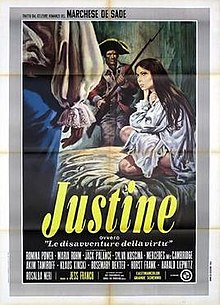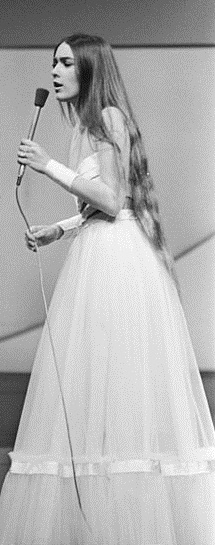Marquis de Sade: Justine
| Marquis de Sade: Justine | |
|---|---|
 Italian theatrical release poster for Marquis de Sade: Justine | |
| Directed by | Jesús Franco |
| Screenplay by | Harry Alan Towers[1] (as Peter Wellbeck) |
| Based on | Justine ou les malheurs de la vertu by Marquis de Sade[1] |
| Produced by |
|
| Starring | |
| Cinematography | Manuel Merino[1] |
| Edited by |
|
| Music by | Bruno Nicolai[1] |
Production companies |
|
| Distributed by |
|
Release dates |
|
Running time | 124 minutes |
| Countries |
|
| Language | English |
Marquis de Sade: Justine (Italian: Justine ovvero le disavventure della virtù, lit. 'Justine or the misadventures of virtue', also released as Deadly Sanctuary)[1] is a 1969 erotic period drama film directed by Jesús Franco, written and produced by Harry Alan Towers, and based on the 1791 novel Justine by the Marquis de Sade. It stars Romina Power as the title character, with Maria Rohm, Klaus Kinski, Akim Tamiroff, Harald Leipnitz, Rosemary Dexter, Horst Frank, Sylva Koscina and Mercedes McCambridge.
The film is set in 1700s France where Justine (Power) and her sister Juliette (Rohm) are orphans in Paris. Juliette becomes a prostitute and marries a rich noble. Justine is falsely arrested and sentenced to death, then escapes from prison to become a fugitive.
The film was an international co-production between West Germany and Italy. Justine had Franco's largest budget to date, of just under a million dollars. Franco originally wanted to cast Rosemary Dexter as Justine, but was forced to cast Romina Power[2] in the role, which led to Franco changing the story to suit her.
Plot
[edit]In Paris during the late 18th-century, Justine lives with her sister Juliette in a convent. When they learn of their father's death, they are ordered out of the convent with their father's remaining gold. Juliette takes Justine to a friend, Madame de Buission, a brothel owner who requires the girls to work as prostitutes in return for accommodation. Justine refuses and leaves the brothel with her gold while Juliette stays. Juliette and a fellow prostitute named Claudine kill Madame de Buisson and one of her clients, stealing her gold and making their escape.
A man named Du Harpin agrees to let Justine stay for free if she serves as his maid. Du Harpin's master forces himself on Justine. She escapes but is instructed by Du Harpin to steal the man's gold amulet. Justine refuses. While she is asleep, Du Harpin places the amulet in Justine's belongings to frame her, out of spite for her having refused to steal it for him. The next day, police find the amulet in Justine's belongings. Justine is taken to prison where she meets Madame Dubois, a virago sentenced for execution. Madame Dubois, impressed by Justine's innocent looks, includes her in an escape plan. The next day, Madame Dubois and Justine escape the prison safely.
While hiding out in a forest, Madame Dubois accepts Justine as part of her group. The male members of the group attempt to rape Justine. She escapes and faints near the house of a painter named Raymond, who makes her his model. They fall in love and live happily until the police arrive at Raymond's home, searching for Justine, and she must escape again.
Justine becomes a personal attendant to the Marquise de Bressac, whose husband asks Justine to kill his wife or be framed for a crime. The Marquise attempts to poison her husband, but he tricks her into drinking his wine, killing her. To punish Justine, the Marquis brands the letter 'M' for 'Murderess' on Justine's breast.
Justine arrives at a chateau where four ascetics are living a life of meditation and study. Justine asks for sanctuary there and is accepted by the Order. She learns, however, that the four men are sexual deviants whose four other female servants are, in fact, sex slaves. Justine ends up chained and tortured in the dungeon. Father Antonin suggests that Justine's sense of pleasure is enduring her suffering, to which Justine agrees. Pleased at having learnt their philosophy so swiftly, Antonin plans to "release" her by killing her in torture during a ritual. The ceremony goes awry and Justine escapes in the commotion.
Raymond finds Justine unconscious on the road and takes her to a nearby city. Madame Dubois spies Justine and takes her away to work as a nude show performer. During the show, Justine's brand causes an uproar in the venue. As she is being taken away by the police, she is spotted by Juliette, now a mistress of a Minister of the King. Juliette describes her wicked life as empty and says that Justine will earn her reward for a virtuous life despite her sufferings.
Juliette takes Justine away to live with her in her palace and finally, Justine and Raymond are seen walking away peacefully.
Cast
[edit]
- Romina Power as Justine
- Maria Rohm as Juliette
- Klaus Kinski as the Marquis de Sade[1]
- Harald Leipnitz as Raymond
- Jack Palance as Father Antonin
- Rosemary Dexter as Claudine
- Akim Tamiroff as du Harpin
- Horst Frank as Marquis de Bressac
- Sylva Koscina as Marquise de Bressac
- Mercedes McCambridge as Madame Dubois
- Carmen de Lirio as Madame de Buisson
- Gustavo Re as Descroches
- José Manuel Martín as Victor
- Rosalba Neri as Florette
- Claudia Gravy as Olivia
- Gérard Tichy as Comte de Courville
- Howard Vernon as Father Clement
- Angel Petit as Jasmin
- Mike Brendel as Pierre
- Serena Vergano as a prisoner
- Luis Ciges as Manuel
- Jesús Franco as Master of Ceremonies
Production
[edit]After working on the film The Blood of Fu Manchu, producer Harry Alan Towers and director Jesús Franco wanted to make a film more aimed at an adult audience.[4] Following Franco's desire to make an erotic film, Towers began writing a script based on Justine ou les malheurs de la vertu.[4][5] The film had a budget that was less than one million dollars but was still Franco's highest budget film at the time.[5]
Rosemary Dexter was originally intended to portray Justine, but only appears briefly in the role of Claudine.[6] Romina Power's role in the film was forced on Franco by a Hollywood financer, which angered Franco as he felt that Power lacked the acting experience and sensuality that the role required.[5] Franco altered the story to fit her, which he felt diluted the essence of de Sade's original story.[5]
Filming took place in Franco's home country of Spain, in and around Barcelona. Locations included Palau Nacional, Montjuïc Castle, Park Güell, Plaça del Rei, and Plaça de Sant Felip Neri. The film was shot in English, and later dubbed in Italian and German.
Release
[edit]Marquis de Sade: Justine was released in Italy on 3 April 1969 and in West Germany on 13 June 1969.[1][6] In the United States, the film was distributed by American International Pictures. The film was heavily censored on its release with running times ranging from 120, 105, 93 and 90 minutes.[6]
Reception
[edit]This section needs expansion. You can help by adding to it. (February 2015) |
Robert Firsching for Allmovie gave the film two stars, referring to it as an "uneven adaptation of the Marquis de Sade's notorious Justine".[6]
"... a lavishly appointed costume drama leavened with lashings of kinky sex, tantamount to Tony Richardson’s Tom Jones with full frontal nudity."[7]
"more parable in here than perversion"[8]
Home video
[edit]The film was released on DVD by Blue Underground on 27 January 2004. The DVD includes an interview with Jess Franco and Harry Alan Towers.[9] It was released on a Region 2 DVD on 27 January 2003 by Anchor Bay Entertainment.[10]
See also
[edit]- Cruel Passion, another film adaptation of the same novel
- Klaus Kinski filmography
- Marquis de Sade in popular culture
- List of German films of the 1960s
- List of Italian films of 1969
Notes
[edit]- ^ a b c d e f g h i j k "Marquis de Sade: Justine". Filmportal.de. Retrieved 20 February 2013.
- ^ Marino, Jamie (9 May 2018). "Searching for Franco: "Marquis de Sade: Justine"". Morbidly Beautiful. Retrieved 26 May 2023.
- ^ Haflidason, Almar. "Justine DVD (1969)". BBC. BBC. Retrieved 20 February 2013.
- ^ a b Shipka, 2011. p.193
- ^ a b c d Shipka, 2011. p.194
- ^ a b c d Firsching, Robert. "Justine". Allmovie. Rovi Corporation. Archived from the original on 5 August 2012. Retrieved 20 February 2013.
- ^ Wilkins, Budd (27 February 2023). "Career of Evil: Jess Franco's Adaptations of the Marquis de Sade's Justine and Eugenie". Slant Magazine. Retrieved 26 May 2023.
- ^ "A Tale Of Two Sisters - The Erotic/Non-Erotic Tale Of 1969's 'Marquis de Sade's Justine'". SCIFIHISTORY.NET. 16 February 2023. Retrieved 26 May 2023.
- ^ "Marquis de Sade's Justine". Blue Underground. Retrieved 20 February 2013.
- ^ "Justine". Allmovie. Rovi Corporation. Retrieved 20 February 2013.
References
[edit]- Shipka, Danny. Perverse Titillation: The Exploitation Cinema of Italy, Spain and France, 1960–1980. McFarland, 2011. ISBN 978-0-7864-4888-3.
